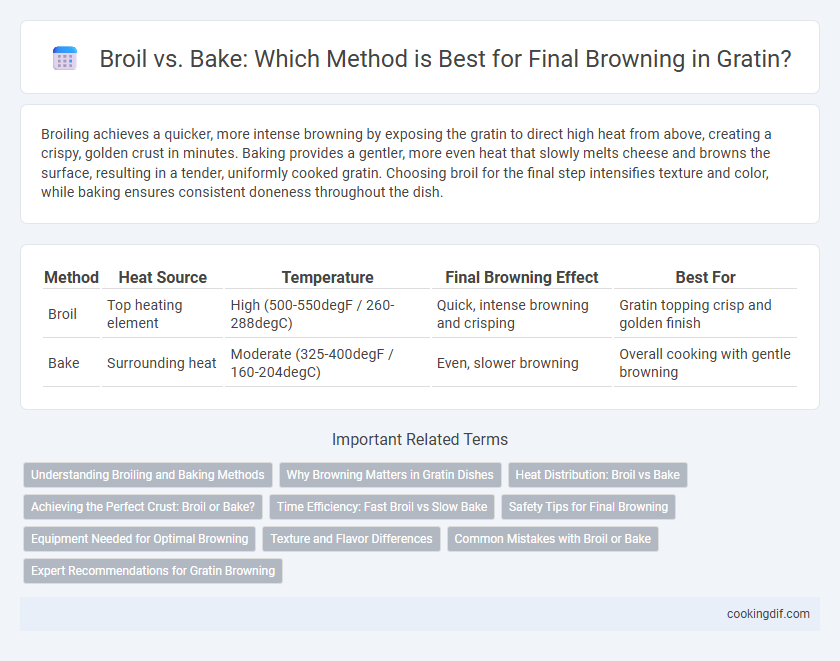Broiling achieves a quicker, more intense browning by exposing the gratin to direct high heat from above, creating a crispy, golden crust in minutes. Baking provides a gentler, more even heat that slowly melts cheese and browns the surface, resulting in a tender, uniformly cooked gratin. Choosing broil for the final step intensifies texture and color, while baking ensures consistent doneness throughout the dish.
Table of Comparison
| Method | Heat Source | Temperature | Final Browning Effect | Best For |
|---|---|---|---|---|
| Broil | Top heating element | High (500-550degF / 260-288degC) | Quick, intense browning and crisping | Gratin topping crisp and golden finish |
| Bake | Surrounding heat | Moderate (325-400degF / 160-204degC) | Even, slower browning | Overall cooking with gentle browning |
Understanding Broiling and Baking Methods
Broiling uses direct, high heat from above to quickly brown and crisp the gratin's top layer, creating a golden crust without cooking the interior further. Baking applies consistent, surrounding heat at lower temperatures, evenly cooking the gratin throughout while slowly developing color and texture. Choosing broil for final browning enhances crispiness and caramelization, whereas baking ensures thorough cooking with gentle, uniform heat distribution.
Why Browning Matters in Gratin Dishes
Browning in gratin dishes enhances flavor through Maillard reactions, creating complex, savory notes and a contrasting texture that balances creamy layers. Broiling provides intense, direct heat ideal for rapid, crispy browning of cheese and breadcrumbs without overcooking the interior. Baking, while gentler, ensures even cooking but may require finishing under the broiler to achieve the perfect golden crust essential for authentic gratin appeal.
Heat Distribution: Broil vs Bake
Broiling applies intense, direct heat from above, creating rapid browning and crisping on the gratin's surface. Baking uses even, surrounding heat at a lower temperature, ensuring uniform cooking and tender interior texture. Optimal heat distribution depends on desired crust thickness and overall doneness in gratin preparation.
Achieving the Perfect Crust: Broil or Bake?
Broiling achieves the perfect crust by exposing the gratin to intense, direct heat that rapidly caramelizes the top layer, producing a crisp, golden-brown finish. Baking gradually cooks the gratin evenly, allowing the cheese and breadcrumbs to melt and brown subtly, but may require longer time to develop a crust. For optimal results, broil in the final minutes of baking to combine even cooking with a perfectly browned, crunchy crust.
Time Efficiency: Fast Broil vs Slow Bake
Broiling offers rapid final browning due to intense direct heat, significantly reducing cooking time compared to baking. Baking provides even, gradual browning but requires longer durations, making it less time-efficient for a quick gratin finish. Choosing broil optimizes time efficiency while achieving a crisp, golden crust on gratins.
Safety Tips for Final Browning
Broiling achieves a crisp, golden-brown finish on gratins by exposing the dish to high, direct heat from above, requiring close monitoring to prevent burning or smoke hazards. Baking provides more even heat distribution, reducing the risk of over-browning but takes longer to develop the desired crust. For safety, always use oven mitts when handling hot pans, keep the broiler door slightly ajar if recommended, and never leave the oven unattended during the broiling process.
Equipment Needed for Optimal Browning
Broiling requires an oven with a functional broiler element positioned close to the food for intense, direct heat, ideal for achieving a golden, crispy gratin top. Baking necessitates consistent, even heat circulation, often best achieved with a convection oven that evenly distributes warmth to brown the surface without burning. Using a broiler pan or a shallow, oven-safe dish enhances heat exposure and prevents sogginess by allowing excess moisture to evaporate during the final browning phase.
Texture and Flavor Differences
Broiling a gratin creates a crisp, golden crust with intense caramelization, enhancing nutty and savory flavors while maintaining a tender interior. Baking produces a more evenly cooked dish with a softer top layer, allowing flavors to meld together gently and resulting in a creamier texture. The choice between broil and bake for final browning directly affects the gratin's overall mouthfeel and taste complexity.
Common Mistakes with Broil or Bake
Common mistakes with broiling or baking gratin for final browning include applying broil at too high a temperature, which can cause uneven charring while leaving the interior underheated. Baking at low temperatures throughout often results in a pale, unappetizing crust lacking the desired golden-brown texture. Misjudging the timing for switching from bake to broil frequently leads to either a burnt top or an insufficiently browned gratin surface.
Expert Recommendations for Gratin Browning
Experts recommend broiling for achieving a crisp, golden-brown crust on gratins due to its intense, direct heat that quickly caramelizes the top layer. Baking, while providing even heat distribution, often results in a softer, less browned surface, making broiling the preferred choice for final browning. To prevent burning, chefs advise monitoring the gratin closely during broiling, typically for 2-5 minutes at high temperature.
Broil vs Bake for final browning Infographic

 cookingdif.com
cookingdif.com